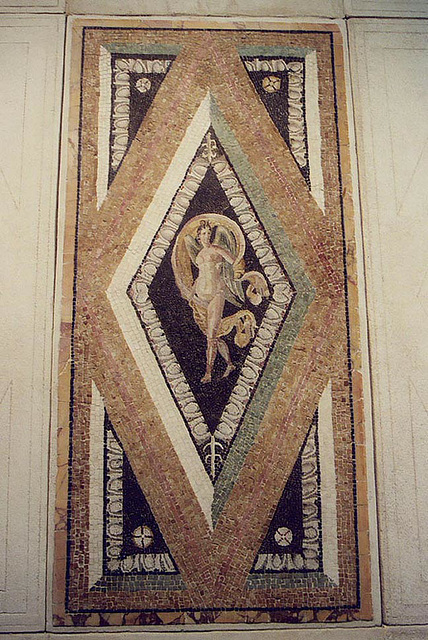Villa Floor Plan in the Palazzo Massimo alle Terme…
Red Background Wall Painting in the Palazzo Massim…
Urn Wall Painting from Livia's Villa of Prima Port…
Wall Painting in the Palazzo Massimo alle Terme Mu…
Wall Painting in the Palazzo Massimo alle Terme Mu…
Detail of a Wall Painting of a Caryatid in the Pal…
Detail of a Wall Painting of a Caryatid from the P…
Wall Painting in the Palazzo Massimo alle Terme Mu…
Porta Del Popolo and Santa Maria Del Popolo in Rom…
Fountain in Piazza del Popolo in Rome, 2003
Piazza Del Popolo in Rome at Dusk, Nov. 2003
Sculptures on the Pincio Hill in Rome, Dec. 2003
The Church of Santa Maria in Montesanto in Rome, 2…
Sculptures on the Pincio Hill in Rome, Dec. 2003
The Crucifixion of St. Peter by Caravaggio in the…
Servian Wall Remains Near Termini Train Station in…
Servian Wall Remains Near Termini Train Station in…
Bocca Della Verita in Rome, Dec. 2003
The Farnese Gardens on the Palatine Hill in Rome,…
View of the Palatine Hill from the Forum in Rome,…
View of the Countryside from the site of Paestum,…
Plan and Reconstruction of the Heroon in Paestum,…
The Heroon in Paestum, November 2003
Mosaic in the Palazzo Massimo alle Terme Museum in…
Geometric Mosaic With a Central Insert in the Pala…
Black and White Geometric Mosaic in the Palazzo Ma…
Reclining Woman at the Baths of Diocletian in Rome…
Relief Sarcophagus in the Baths of Diocletian in R…
Reclining Couple on a Sarcophagus in the Baths of…
Relief Sarcophagus in the Baths of Diocletian in R…
Relief Sarcophagus with the Myth of Selene and End…
Strigel Sarcophagus in the Baths of Diocletian in…
Reclining Woman on a Sarcophagus in the Baths of D…
Sarcophagus with Erotes Supporting a Clipeus from…
Sarcophagus with Erotes Supporting a Clipeus in th…
Sarcophagus with Erotes in the Baths of Diocletian…
Sarcophagus with Winged Victories in the Baths of…
Theatrical Masks on a Sarcophagus in the Baths of…
Headless Statue of a Draped Woman in the Baths of…
Latin Inscription in the Baths of Diocletian in Ro…
Headless Statue of Venus in the Baths of Diocletia…
Headless Statue of an Old Man (Old Fisherman?) in…
Statue of a Headless Man (Apollo or Hermes?) Weari…
Statue of a Headless Togate Man in the Baths of Di…
Statue of Ganymede with Jupiter as an Eagle in the…
See also...
Keywords
Authorizations, license
-
Visible by: Everyone -
All rights reserved
-
359 visits
Detail of a Mosaic in the Palazzo Massimo alle Terme Museum in Rome, Dec. 2003


Palazzo Massimo was built at the end of the nineteenth century as the part of a college. Today it forms part of the National Roman Museum. Exhibits are spread across four floors of the palace. On the ground floor is the Numismatic Section which holds fascinating examples of coinage and monetary systems from their origins in the eighth century B.C. to the introduction of the Euro. Included here are also several gems, jewels and jewellery of the Savoia collection and the section of Oreficeria, most of which served as funerary items. Among these is the mummified "Bambina di Grottarossa", a child found together with its doll. On the other three floors various works of art representing a broad range of classical sculpture are exhibited. These include a statue of Augustus, various Roman copies of Greek statues such as those as the famous "Discobolo Lancellotti", a sleeping Hermaphrodite, Venus about to take a bath, and Apollo which was copied from a fifth century B.C. Greek original in the workshops of Fidia. There is also a section of interesting bronzes. The final floor is dedicated to a wonderful collection of frescoes and mosaics, among them those of the triclinium of the villa of Livia and those of the villa Farnesina. Together these exhibits represent the themes and styles which existed from the first century B.C. to the fourth century A.D. and come from various locations around the city of Rome. Among the most interesting of these is a marbles in laid work representing the Sun God.
Text from: www.italytraveller.com/en/r/rome/c/palazzo-massimo
For more information (in Italian): www.archeorm.arti.beniculturali.it/sar2000/Museo_romano/P...
Text from: www.italytraveller.com/en/r/rome/c/palazzo-massimo
For more information (in Italian): www.archeorm.arti.beniculturali.it/sar2000/Museo_romano/P...
- Keyboard shortcuts:
Jump to top
RSS feed- Latest comments - Subscribe to the comment feeds of this photo
- ipernity © 2007-2024
- Help & Contact
|
Club news
|
About ipernity
|
History |
ipernity Club & Prices |
Guide of good conduct
Donate | Group guidelines | Privacy policy | Terms of use | Statutes | In memoria -
Facebook
Twitter

Sign-in to write a comment.